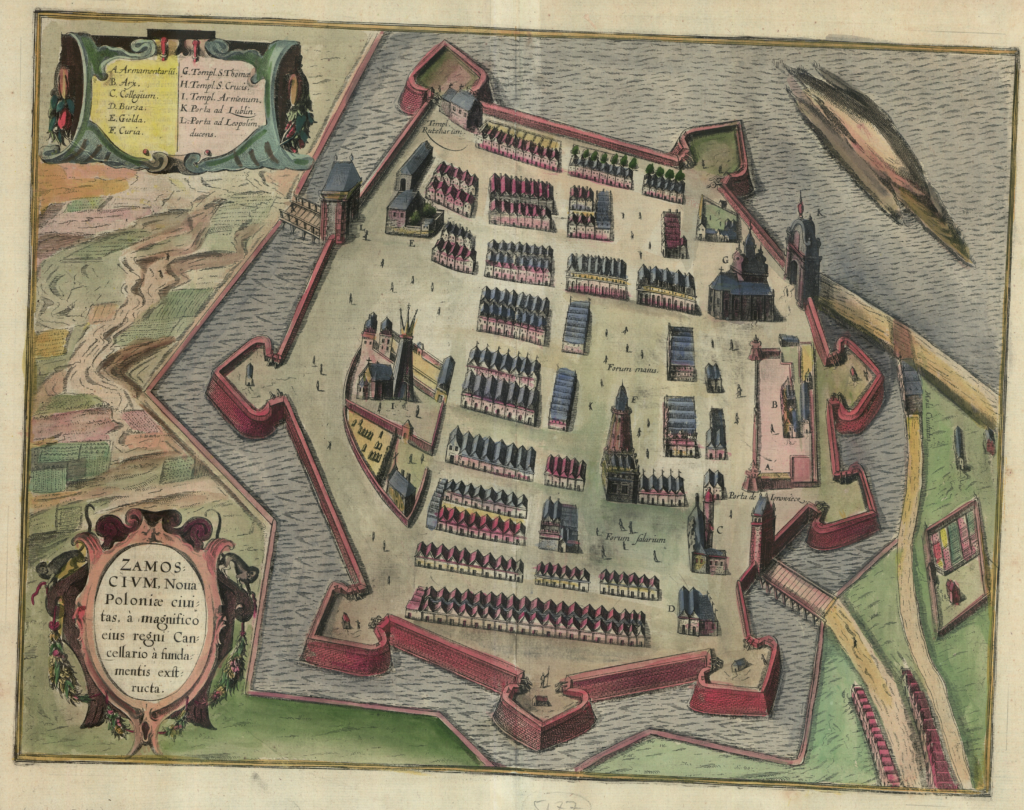Three hundred years ago, on 17 September 1720, the last session of a Uniate synod concluded in St Nicholas Church in Zamość. This ecclesiastical body enacted statutes that continue to shape the Greek Catholic community and, as a consequence, our whole region until this very day.

The Synod of Zamość, as it came down in history, crowned a long evolution of Poland-Lithuania’s Uniates (the name given to the Greek Catholics at that time) as an independent ecclesiastical community. This process started in the second half of the sixteenth century with attempts to reform and elevate the Ruthenian Orthodox Church, weakened by the competition from both Protestants and Catholics, the latter recently reinvigorated by the reforms of Trent. In 1596, hoping for a breakthrough, Poland-Lithuania’s Orthodox bishops accepted the terms of the 1439 Union of Florence and pledged allegiance to the pope in Rome, retaining their Byzantine-Slavonic rite and hierarchy. Many Orthodox Ruthenians saw this move as a betrayal of their faith and rejected the reforms. The fathers of the 1596 Union of Brest meant to provide a stimulus to Poland-Lithuania’s Eastern Christians as a whole and to enable them to flourish, but it instead led to internal strife and the eventual emergence of two competing denominations: the Uniates and the Orthodox.
Paradoxically, the calamities of seventeenth-century wars and the violent separation of the predominantly Orthodox Left-bank Ukraine allowed the Uniates to gain the upper hand in the Polish-Lithuanian Commonwealth. Without the backing of the Orthodox Cossacks and nobles from across the Dnipro, Poland-Lithuania’s Eastern Christian churchmen drifted towards Uniate Catholicism; by the beginning of the eighteenth century the last Orthodox bishoprics had accepted the Union. Orthodox Christians survived in the Commonwealth only as a minority scattered in small pockets.
The Synod of Zamość convened in 1720 to regulate the situation of this newly victorious Uniate Church. A brainchild of the Kyiv Metropolitan Lev Kyshka, the assembly was presided by the Papal Nuncio Girolamo Grimaldi. Its significance for the Uniates is comparable to that of the Council of Trent for the Catholic Church as a whole. Just like the Milanese synods convened by Carlo Borromeo in the 1560s and 1570s, the Zamość Fathers created a sort of constitution that translated Trent’s general principles into local practice. In this way it stabilised the liturgical and institutional framework within which the Uniate Ruthenians functioned. Without entering here into the niceties of scholarly discussions, confessional polemics, and administrative scuffles that surround specific stipulations of the Synod, it cannot be denied that for better or worse, eighteenth-century Uniate Catholicism provided its adherents with a strong identity contrasting with those of its Orthodox and Latin Catholic competitors. 1
In 1787 Iraklii Lisovsʹkyi, a Uniate archbishop, who for political reasons looked down upon many traditions of his own Church, characterised the liturgical practices that had emerged in the aftermath of the Synod of Zamość as a vizioso miscuglio, or a corrupt mishmash (in Larry Wolff’s translation). Precisely this miscuglio, this organic blend of heterogeneous elements, constituted the differentia specifica of the Uniate community and endowed it with a viable identity of its own. In this way, the Uniate Church contributed decisively to the development of Poland-Lithuania’s Ruthenians as a separate group and, consequently, to shaping robust national identities among Ukrainians and Belarusians. This, as we can all see now, has been a matter of no small consequence.
Yet, despite its evident weight, the Synod of Zamość remains a curiosity remembered only by professional historians and church buffs. The wider public in both Poland and Ukraine, not to mention Belarus, virtually ignored the Synod’s three-hundredth anniversary. For example, during his state visit to Ukraine in October 2020, Poland’s president focused exclusively on the commemoration of twentieth-century events. The Covid pandemic cannot be blamed for the neglect of the Synod of Zamość, because the 1920 Polish victory over the invading Bolsheviks was nevertheless debated and celebrated in sundry ways. The same is true for the short-lived Ukrainian People’s Republic (UNR) of 1917-1920. Both these events are undeniably important, but it is hard to overlook the fact that they bore only very fleeting fruits. The peace treaty of Riga of 1921 was an eighteen-year truce, whereas the short-lived UNR is more of a symbol than anything else. In a contrast, the Synod of Zamość proved a victory with long-lasting political and cultural ramifications.
The nightmarish experience of the twentieth century has obscured our vision and deprived our societies of the sense of proportion. We have become, and not only in Eastern Europe, suffering junkies: we are addicted to savouring the violence and destruction inflicted upon our communities. Anything prior to 1914 seems to be a myth, good only for the youngest of pupils, while right-wing politicians and scholars of memory outdo each other in brandishing collective traumas of the past one hundred years.
17 September, the day on which the Synod of Zamość concluded its proceedings, is in fact one of the most recognisable anniversaries in Poland and Western Ukraine. On this day in 1939 Hitler’s Soviet allies dealt a death blow to the struggling Republic of Poland, opening Eastern Europe’s darkest hour. This is what we choose to remember. The Synod of Zamość, in turn, reinforced religious and national identities that no imperial power managed to erase or fully control. This we choose to forget.
Goodbye to all that. Here’s a toast to the Synod Fathers!
⸻⸻⸻⸻⸻⸻⸻⸻⸻
1 It is not possible to summarise here all the regulations of 1720, but I will mention some of the most characteristic ones to substantiate my claim about the Synod’s importance. According to the Orthodox critics, the Zamość resolutions sullied the Eastern Christian tradition with illicit grafts from the Latin Catholic Church. The general tenor of Zamość was to bring the Uniate Church more into line with Catholic doctrine and uses, but at the same time to maintain it as an autonomous body, as it was expressly stated that “it is certain that everyone has the duty to stick in this regard to their custom and to preserve the rite of their Church”. In some respects, the Synod actually pushed back the creeping grassroots Latinisation of Uniate practice, for example when it emphatically prohibited Uniate priests from using unleavened bread in the Eucharist.
The Synod reiterated the indispensability of filioque in the public profession of faith and demanded that popes be mentioned in church prayers. Under the influence of the Latin Catholic sensitivity, it provided for the strict treatment of all matters related to the Eucharist. Several Ruthenian traditions that endangered the purity of the Blessed Sacrament were abolished. For example, in accordance with one especially colourful custom, a newly baptised infant would dip its tongue in the Blood of Christ. The Synod Fathers resolved that this and similar uses had to be abandoned. In the same vein, they introduced to the Uniate calendar the feast of Corpus Christi, which celebrates the miracle of Eucharist. Pope Urban IV established this important holiday only in the second half of the thirteenth century, a couple of years after the expulsion of Latin Crusaders from Constantinople, the point of no return in the Catholic-Orthodox split. Even today Corpus Christi is one of the most prominent features setting Catholics apart from other Christian confessions. The Synod confirmed also the cult of the Blessed Josaphat Kuntsevych, while forbidding to venerate the medieval Orthodox mystic Gregory Palamas.
Despite the fact that such practices went against an older Eastern Christian tradition, the Fathers gathered in Zamość obliquely accepted the presence of side-altars and the possibility of celebrating more than one mass a day in Uniate churches. In the course of the seventeenth century Uniate clergy, following the example of Latin Catholics and motivated by several practical reasons, gradually introduced these innovations at the grassroots.
In accordance with the requirements of the Council of Trent, the Synod ordered that Uniate bishops establish diocesan seminaries, but they barely implemented this before the partitions of the Commonwealth. As a consequence, there was always a painful dearth of competent secular clergymen, which allowed the Basilian monks to virtually monopolise all the lucrative positions in the Uniate hierarchy. Instead of trying to remedy this awkward situation, the Fathers of Zamość resigned themselves to institutionalising the exclusive right of the Basilians to become bishops (this stipulation was highhandedly disregarded by the Austrian government after 1772). As for the Basilian monasteries of the Commonwealth, the Synod envisaged their unification into one congregation, which was indeed established in the early 1740s.
Finally, the Synod Fathers reinforced the importance of the Zamość statutes by demanding their publication in the vernacular and requiring every parish priest to get a copy. The latter stipulation was completely unrealistic in the circumstances of Poland-Lithuania’s Eastern Christian provinces; the former one was carried out in 1743 by the Metropolitan Atanasii Sheptyts’kyi who had the statutes published in Ruthenian. This edition soon became a rarity and only eighteen copies are known to have survived until today, but in the 1780s a Polish-language version appeared. The relative inaccessibilty of the Ruthenian translation of the statutes was alleviated to some extent by the immediate release of a popular catechism-style compendium in that language. [Note: An earlier version of this footnote mistakenly claimed that there was no Ruthenian translation of the synod statutes in the eighteenth century.]
To learn more about the Synod of Zamość and its consequences see the following works: Ludomir Bieńkowski, “Organizacja Kościoła Wschodniego w Polsce,” in Jerzy Kłoczowski, ed., Kościół w Polsce. II: Wieki XVI–XVIII (Cracow, 1969), 781-1049; Andrzej Gil & Ihor Skoczylas, Kościoły wschodnie w państwie polsko-litewskim w procesie przemian i adaptacji: metropolia kijowska w latach 1458-1795 (Lublin, 2014); Edward Likowski, Dzieje Kościoła unickiego na Litwie i Rusi w XVIII i XIX wieku: uważane głównie ze względu na przyczyny jego upadku. Cz. 1 (Warsaw, 1906); Przemysław Nowakowski CM, ed., Statuty synodu zamojskiego 1720 roku: Nowe tłumaczenie z komentarzami (Cracow, 2020); Przemysław Nowakowski CM, ed., Dziedzictwo synodu zamojskiego 1720-2020: Wyzwania i perspektywy (Cracow, 2021); Iuliian Pelesh, Geschichte der Union der ruthenischen Kirche mit Rom von den ältesten Zeiten bis auf die Gegenwart. Bd. 2, Von der Wiederstellung der Union mit Rom bis auf die Gegenwart (1598-1879) (Vienna, 1880); Ernst Christoph Suttner, “Die Synoden von Zamošč (1720) und Wien (1773) als prägende Ereignisse für die Unierten Polens und der Donaumonarchie,” Ostkirchliche Studien, Vol. 44 (1995), Issue 4, 273-291; Larry Wolff, Disunion within the Union: The Uniate Church and the Partitions of Poland (Cambridge, MA, 2020).
⸻⸻⸻⸻⸻⸻⸻⸻⸻
This is not an academic text sensu stricto. Its goal is to disseminate knowledge and to stimulate public interest in our field. The views and opinions expressed here are those of the author and do not necessarily reflect the official policy or position of either PAN or NCN.


One Reply to “A vizioso miscuglio? 300 years since the Synod of Zamość”
Comments are closed.